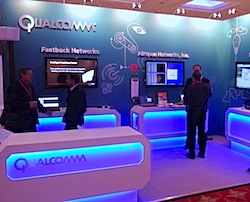Qualcomm Atheros has announced an integrated 3G/4G LTE small cells processor portfolio designed for pico, metro and enterprise small cells, as part of a big push into the network infrastructure market.
The vendor’s new FSM99xx portfolio features 28 nanometre chipsets and software designed to support operators’ concurrent 3G and 4G networks, dual carrier 4G with carrier aggregation, as well as hosting advanced Wi-Fi capabilities.
The chips use Qualcomm’s implementation of the ARM quad core Krait mobile processors to half the power used by other processors, while RF linearisation techniques reduce power amplifier power consumption.
Power amplifier power consumption makes up a big part of the current small cells “power budget”, Stuart Strickland, director of Qualcomm Atheros’ Product Strategy Networking Business Unit, told Mobile Europe.
“Power is a big concern as small cells will be powered by Ethernet, so we’re designing chipsets that support that,” he said.
Moreover, the director said the company had “laid the groundwork” for the new solution to host multiple radio technologies.
“The chip has LTE and 3G capabilities, but it also has a modular approach that can add wireless backhaul capability and Wi-Fi capability, which can be plugged down to the host processor,” Strickland commented.
This modularity approach enables Qualcomm Atheros to offer techniques for advanced HetNet and self-organising networks (SON) as part of the FSM99xx portfolio, such as the Qualcomm UltraSON suite.
Small cells are meant to be intelligent, autonomous devices that can sense and adapt to changes in its user environment, whether it’s an increase in traffic or detecting that another small cell nearby has stopped working.
“A lot of these networks will be rolled out in an unplanned, dynamic way, where you have a gradual saturation of an area. We need to be able to provide organisational algorithms that are predictable,” said Strickland.
“Not only do we need to make sure that small cells don’t interfere with the macro network or with each other, but also if the carrier decides to roll out one small cell for every 10 houses, and then five years later decides to roll out one small cell in every single house, we want to know what to do.”
According to Strickland, the eventual aim is to enable operators to have “mix and match” small cells, with different chips supporting LTE with Wi-Fi for a data-focused approach or LTE and 3G connecting to the host processor.
“In the longer term, we’re going to make the host more robust, capable of supporting higher throughputs, supporting multiple Wi-Fi radio frequencies. Right now, carrier devices host four, six or eight Wi-Fi chips and a single host,” he said.



